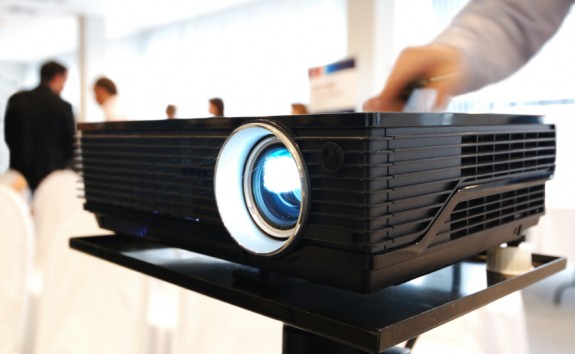Humans are very visual creatures. No matter how compelling your speech or how you deliver it, people are wont to doze off without the prodding of images. In this attention-deficit society, the importance of visual guidance hits home.
As a result, projections have become inextricable from presentations. It’s one thing to present to a crowd of three. In that case, a tablet or laptop will do. But if you’re speaking to a hundred, then a projection system is already in order.

This guide will show you how to make the most of your presentation with a projector.
Front Projection vs. Rear Projection
First, you need to determine whether you need a rear or front projector. Most of the time, the most logical answer seems to be the former.
Think about it: When you’re presenting, you’re always moving in front of the projector screen. The tendency is that you, if not your audience, cast shadows on the presentation. Rear projection eliminates opportunities for shadow play.
A rear projection is viewable in a room with all the lights on while a front projection thrives in complete darkness. Since a rear projector is behind the screen, spectators are spared any distracting noise that comes with projectors. Also, they need not worry about tripping on wires.
Then again, a rear projector requires depth, i.e. plenty of space between screen and projector, to properly magnify the image. Fortunately, newer models come with mirrors that minimise such spatial demands. These models are usually more expensive than front projectors.
When installed overhead, front projectors offer a more cost-effective way to facilitate a presentation. They demand less depth, allowing for more sizable projections and wider viewing angles.
Brightness
Light obviously factors in your choice of projection system. As you may know, projector brightness is measured in units called lumens.
Presentations often take place in lit rooms, making possible note-taking, audience participation and eye contact. To stand a chance in ambient light, a projector needs to have at least 3,000 lumens. But projector brightness of the first magnitude—4,500 to 12,000 lumens—is imperative if the projector is going to be located far from the screen, e.g. in a concert hall. Such degree of illumination lets the audience appreciate the nuances of an image.
In other cases, brightness is not a necessity. Presentations that mainly involve videos, photographs, and oversized text are typically done in darkened rooms. As such, they call for less than 2,000 lumens: the capacity of many small, mobile projectors flooding the market.
Regardless of lumens, make sure to bring an extra projector bulb. You would not want to be caught off your guard mid-presentation. It also pays to check beforehand how the presentation room will be lit.
Type, Size, and Number of Screens
Projector screens are efficient light reflectors, capable of maximising the dimmest projections. Projecting on a wall is out of the question when professional presentations are involved. Otherwise, you have to compensate with an atypically bright projector.
Corporation boardrooms and university lecture halls are known to use motorised screens. These are screens that can be lowered or raised from the ceiling at the switch of a remote control. These are sophisticated innovations on screens that are manually retractable through a system of spring rollers. Both kinds of screens are designed for permanent installation.
There are also non-retractable screens, which can be permanently mounted on a wall. Available in 16:9 and video 4:3 ratios, these screens are built like painting canvases.
If you are a ‘nomadic’ presenter, you’re better off with portable screens that easily roll into cases. Some feature fold-out feet, while others come with tripod stands. Other screens can be set up with a truss skeleton.
You need to match the size and number of screens to your venue and presentation content. One screen is enough if the room is narrow. Conversely, you need at least two in a bigger setting with more people. More screens ensure that spectators at the widest angle can still view the presentation. You also need a larger screen if your presentation relies on graphs, tables, and other fine data.
Other Considerations
Ensure that your projector has compatible inputs with your source devices. Ideally, a projector must have DVI, HDMI, USB, and VGA connectivity, although you can certainly get wireless models.
If your presentation is a mix of PowerPoint slides, HD videos, and image magnification (IMAG), consider a switching device.
Lastly, make sure the projector is a breeze to handle: easy to set up, zoom, focus, and power up. Don’t forget that extra bulb, just in case!


